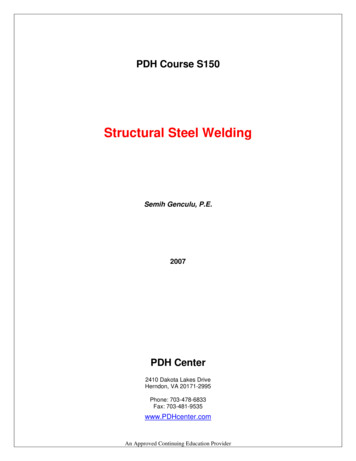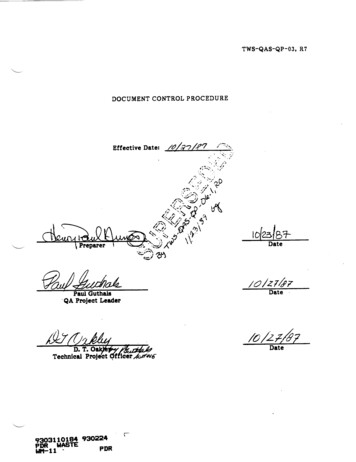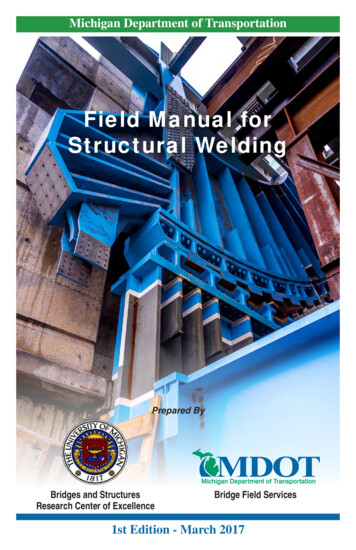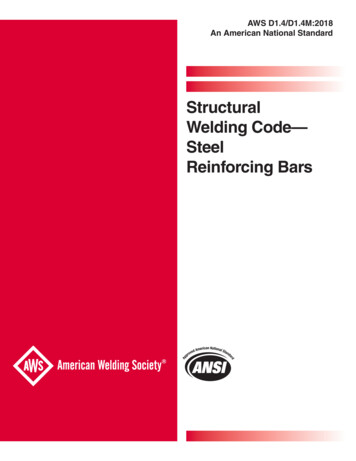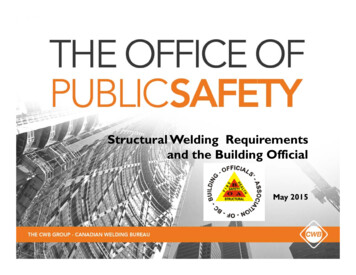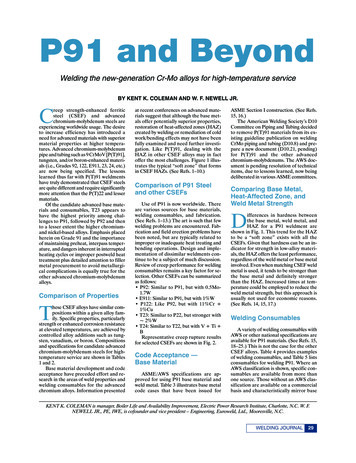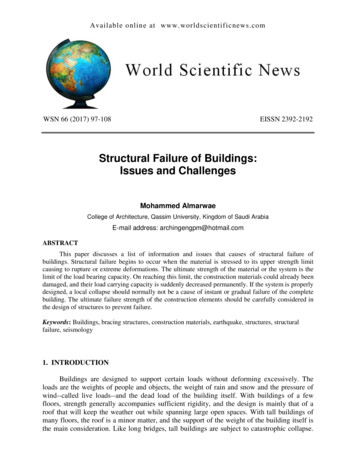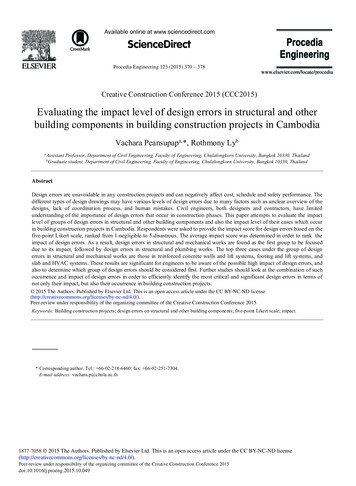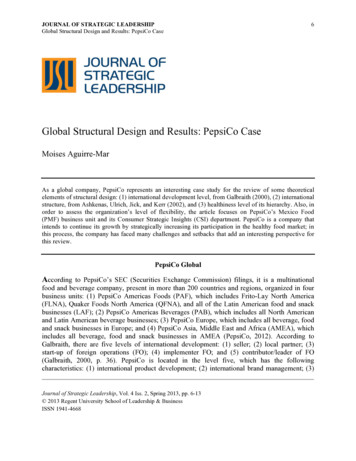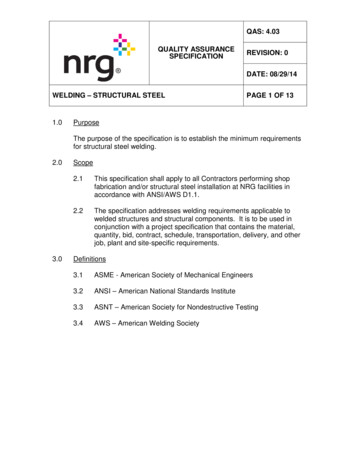
Transcription
QAS: 4.03QUALITY ASSURANCESPECIFICATIONREVISION: 0DATE: 08/29/14WELDING – STRUCTURAL STEEL1.0PAGE 1 OF 13PurposeThe purpose of the specification is to establish the minimum requirementsfor structural steel welding.2.03.0Scope2.1This specification shall apply to all Contractors performing shopfabrication and/or structural steel installation at NRG facilities inaccordance with ANSI/AWS D1.1.2.2The specification addresses welding requirements applicable towelded structures and structural components. It is to be used inconjunction with a project specification that contains the material,quantity, bid, contract, schedule, transportation, delivery, and otherjob, plant and site-specific requirements.Definitions3.1ASME - American Society of Mechanical Engineers3.2ANSI – American National Standards Institute3.3ASNT – American Society for Nondestructive Testing3.4AWS – American Welding Society
Attachment:QAS No.:4.015.14.033.5Contractor – The responsible fabricator or installer.3.6NRG - The NRG individual responsible for the overall managementof the project cost and schedule3.7NRG QA - The NRG individual responsible for the welding andquality aspects of the project3.8Witness Point – Points identified within the Contractor’s WorkProcess Documentation that require the Contractor to notify NRGprior to proceeding. NRG may elect to perform inspections at thattime or waive the right to inspect.3.9Work Process Documentation (WPD) – A tracking form thatdocuments the weld procedure specification being used, theessential details of the welding process (e.g., base metal, fillermetal, preheat, etc.), and any special procedures/techniques,materials and witness points. Work Process Documentation maybe a Removal and Replacement Procedure, Weld Data Sheet,Repair Plan, or Contractor-equivalent form.References4.1ANSI/AWS D1.1,”Structural Welding Code –Steel”4.2ANST TC-1A, “Personnel Qualification and Certification inNondestructive Testing”4.3ASME Boiler & Pressure Vessel Code, Section IX, “QualificationStandard for Welding and Brazing Procedures, Welders, Brazers,and Welding and Brazing Operators”4.4AWS B2.1, “Welding Procedure and Performance Qualification”The latest edition of the above codes, standards, and specifications shallapply. In the event of conflicts between this specification and thereferences cited above, the Contractor shall notify NRG, who will make thefinal judgment and interpretation.5.0Responsibility
Attachment:QAS No.:6.07.015.14.035.1The Contractor shall be responsible for fulfilling the requirements asset forth in this specification including all required welding,inspection, test, and quality control documentation. Exceptions toand deviations from this specification shall be clearly delineated inthe Contractor’s bid for disposition by NRG.5.2The Contractor shall submit Weld Process Documentation for NRGreview and approval prior to the start of work.5.3The Contractor shall identify clearly in their proposal any and allsubcontractors intended to be used. All subcontractors must beapproved by NRG prior to the issuance of a purchase order.5.4NRG shall provide the Contractor with the dimensions, thickness,and material specification and grade of the component beingwelded.5.5NRG shall provide the Contractor with drawings that specify thelocation, type, size, and extent, and surface finish of all welds andthe corresponding weld joint design. Shop and field welds shall beclearly distinguished as well as weld joints for which sequencing isimportant to control shrinkage and distortion.5.6NRG may issue a NRG Quality Assurance Plan that details sitespecific requirements.Welding Procedure Specifications6.1The Contractor shall have weld procedure specifications (WPS)and supporting procedure qualification records (PQR) whichconform to the rules ANSI/AWS D1.1.6.2WPS’s qualified under the ASME B&PV Code, Section IX areacceptable.6.3Contractor’s PQR’s and WPS’s shall be submitted to NRG QA forreview and approval at least two weeks prior to the start of work ata NRG facility. For shop fabrication, PQR’s and WPS’s shall bemade available to NRG QA for review.6.4The gas metal arc welding process (GMAW) shall not be used inthe short circuiting arc transfer mode.Welder Performance Qualification
Attachment:QAS No.:15.14.037.1Contractor’s welders shall be qualified in accordance with theirQuality System and ANSI/AWS D1.1.7.2The Contractor shall submit copies of the welder performancequalifications and proof of continuity to NRG QA for review andapproval prior to the start of work at a NRG facility. For shopfabrication, this information shall be made available to NRG forreview7.3Welders that were previously qualified under the ASME B&PVCode, Section IX are not required to requalify under ANSI/AWSD1.1. However, the welder’s qualification shall be limited by theessential variables of ANSI/AWS D1.1.7.4Welders qualified through “AWS Certified Welder Program” may beaccepted by NRG QA on a case by case basis. If accepted byNRG QA, contractor shall submit welder qualification record andproof of continuity as maintained by AWS Certified Welder Programprocedures.7.5NRG reserves the right to retest any welder performing work at aNRG facility.7.6Welders without current qualifications must qualify on-site. On-sitequalification testing shall comply with Paragraph 7.1 and thefollowing:7.6.1 The Contractor shall notify NRG QA before any on-sitetesting.7.6.2 NRG QA reserves the right to witness or inspect any phaseof the welder qualification test.7.6.3 Upon completion, NRG QA and the Contractor’s QCInspector shall perform a visual inspection of the weldcoupon. The test coupon shall be free .77.6.3.8CracksLack of penetrationIncomplete fusionSurface undercutting exceeding 1/32"Weld reinforcement exceeding 1/8”Root surface concavity exceeding 1/16”Burn through exceeding 1/8”Burn through of the backing ring or plate (whenused)
Attachment:QAS No.:15.14.037.6.3.9 Abrupt valleys between passes. Craters shall befilled to the full cross-section of the weld and theface of the weld shall be flush with the surface of thebase metal.Failure to meet the above criteria shall result in rejection ofthe test coupon.7.6.4 After visual acceptance, radiographic examination or bendtesting shall be performed by the Contactor with acceptancecriteria per ANSI/AWS D1.1 for welder coupons.7.6.5 A welder whose test coupon fails to meet the acceptancecriteria is permitted to take a multi-coupon retest. A welderwho fails the retest is not permitted to take any further testsfor those processes for the duration of the contract.8.0Material Control8.1The Contractor shall furnish Certified Material Test Reports orCertificates of Compliance for any material which shall become anintricate part of the final weld. A Certificate of compliance isacceptable for A36 structural steel. NRG shall provide CertifiedMaterial Test Reports or Certificates of Compliance for materialsupplied to the Contractor by NRG.8.2The base metals to be welded under this specification are carbonand alloy steels commonly used in the fabrication of steel structuresand are listed in ANSI/AWS D1.1. Steels other than those listedmay be used if special qualification requirements are met asdescribed in ANSI/AWS D1.1. Materials used for welding otherthan those listed as prequalified shall be subject to approval byNRG.8.3Welding filler metals shall be as shown in ANSI/AWS D1.1, exceptnon-low hydrogen electrodes are prohibited for shop fabrication andnew construction.8.4Permanent backing materials, when utilized, shall be compatiblewith the base material being welded.8.5The minimum filler metal control requirements are as follows:8.5.1 Portable rod ovens, in working condition, shall be utilized ateach work area.
Attachment:QAS No.:15.14.038.5.2 The following storage requirements apply to electrodes onceremoved from the hermitically sealed containers:8.5.2.1Non-low hydrogen (e.g., E-6010, E-7010-A1) andinconel (e.g., ENiCrFe-2, ENiCrFe-3) electrodes shallbe maintained at room temperature in a secure,clean, and dry environment.8.5.2.2Low-hydrogen (e.g., E-7018, E-801X-BX, E-9018-B3)and austenitic stainless steel (e.g., E-3XX-15/16)electrodes shall be stored at 250 F to 300 F in rodovens with temperature indication.8.5.3 Carbon steel and low alloy electrodes shall not be used aftera period of four hours for E70XX Type, two hours for E80XXType, and one hour for E90XX Type from the time they wereissued from holding ovens or a portable rod warmer. Coatedelectrodes shall be scrapped or redried per themanufacturer’s recommendations if exposure is longer thanspecified above. Coated electrodes that have been wet shallbe discarded. Low-hydrogen electrodes shall not berebaked more than once.8.5.4 Filler metal utilized for GTAW welding shall be identified onboth ends of the wire indicating wire classification.8.5.5 Straight lengths or spooled electrodes and filler metal shallbe suitably protected from being contaminated at the worksite.8.69.0Gas shielding shall be welding grade.Welding9.1Weld end preparations shall be in accordance with the WorkProcess Documentation and ANSI/AWS D1.1.9.2Prior to welding, the base metal surface shall be cleaned at least½" from the end preparation.9.3Welding shall be done only on clean metal, free of cracks, scale,rust, oil, grease, paint, water, or any foreign matter which wouldadversely affect the quality of the weld.9.4Vertical welding shall be performed uphill except that the root passfor double welded joints may be welded downhill provided the root
Attachment:QAS No.:15.14.03is back-gouged and visually inspected prior to welding the oppositeside.9.5Each weld shall be uniform in width and size throughout its fulllength. Each layer of weld passes shall be smooth, free of slag,and shall be completely fused to the adjacent weld bead and/or tothe base metal. The cover pass(es) shall be free of coarse ripples,irregular surfaces, high crowns, crevices, or high ridges, andsuitable for interpretation of any subsequent non-destructiveexamination required.9.6Each weld layer shall be cleaned by suitable means, such asbrushing, filing, grinding or chipping, prior to depositing additionalweld passes and after the final weld layer. Slag shall be removedentirely.9.7Welding shall not be permitted on base metals with a temperaturelower than 32 F (0 C) unless the requirements of the notes toTable 4.2 of ANSI/AWS D1.1 are met. Welding shall not beperformed on surfaces which are wet and the weld area shall beprotected from inclement weather.9.8Any grinding or chipping of welds shall be done so as not to gouge,groove or reduce the base metal thickness.9.9Peening or quenching of welds is not permitted.9.10Oxygen gouging shall not be used on quenched and temperedsteel.9.11Parts to be joined by fillet welding shall be brought into contact asclose as practical. Gaps shall not exceed 3/16" for tee, corner andskewed connections. The separation between faying surfaces oflap joints and of butt joints landing on a backing shall not exceed1/16". Wide welds made to overcome poor fit-up are prohibited.Poor fit-up shall be remedied by suitable means such as basemetal weld build-up and approved by NRG in writing prior toperforming the work.9.12Permanent tack welds shall be made by a qualified welder. Tackwelds are subject to the same quality requirements as the finalwelds except as noted in ANSI/AWS D1.1.9.13All temporary welds shall be removed and base metal visuallyexamined. Removal requires grinding to contour of base metal,unless approved by NRG QA.
Attachment:QAS No.:10.011.015.14.039.14Defective/ rejected welds shall be repaired using the same processused to perform the original weld or with a qualified repairprocedure.9.15No defective weld area shall be repaired by welding more thantwice without written approval from NRG. All repairs shall be madeby the method permitted in ANSI/AWS D1.1.9.16The method for identifying and documenting each welder’s workshall be established between the Contractor and NRG prior to thestart of work.Preheat and Post Weld Heat Treatment10.1The minimum preheat temperatures shall be per the Work ProcessDocumentation.10.2Preheating may be accomplished by utilizing either electricresistance heating pads, induction heating or oxy-fuel torches.10.3Either temperature indicating crayons or contact pyrometers(thermocouples) shall be used for monitoring minimum preheat andmaximum interpass temperature.10.4Post weld heat treatment, if required, will be as indicated in theNRG technical specification, drawings, or design documents.10.5Post weld heat treatment shall be performed in accordance withQAS 4.05.10.6Welds requiring post weld heat treatment shall be preheatedutilizing the same methods (i.e., electric resistance, inductionheating) unless otherwise approved by NRG QA.Work Process Documentation11.1The Contractor shall develop Removal and ReplacementProcedures, Weld Data Sheets, Repair Plans, or Contractorequivalent forms (hereafter referred to as Work ProcessDocumentation) for each type of job.11.2Work Process Documentation shall document the weld procedurespecification being used, the essential details of the weldingprocess (e.g., base metal, filler metal, preheat, etc.), specialprocedures/techniques (e.g., heat treatment), material verification
Attachment:QAS No.:15.14.03and control, witness points, and design control calculations foralterations (see Attachment 8.1 as an example).12.011.3For work at a NRG facility, Work Process Documentation shall besubmitted to NRG QA for review and signature approval prior to thestart of work. For shop fabrication, Work Process Documentationshall be made available to NRG for review.11.4Work Process Documentation shall be posted at the work locationfor reference by the welder, contractor QC and NRG QA.Inspection and Testing12.1The Contractor’s Quality System shall include a formalizedInspection program that includ
7.1 Contractor’s welders shall be qualified in accordance with their Quality System and ANSI/AWS D1.1. 7.2 The Contractor shall submit copies of the welder performance qualifications and proof of continuity to NRG QA for review and approval prior to the start of work at a NRG facility. For shop
